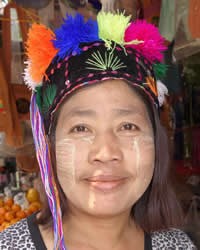De'ang, Pale in China

Photo Source:
Copyrighted © 2026
Kerry Olson All rights reserved. Used with permission |
Send Joshua Project a map of this people group.
|
| People Name: | De'ang, Pale |
| Country: | China |
| 10/40 Window: | Yes |
| Population: | 11,000 |
| World Population: | 312,400 |
| Primary Language: | Palaung, Ruching |
| Primary Religion: | Buddhism |
| Christian Adherents: | 0.12 % |
| Evangelicals: | 0.12 % |
| Scripture: | Complete Bible |
| Ministry Resources: | Yes |
| Jesus Film: | Yes |
| Audio Recordings: | Yes |
| People Cluster: | Mon-Khmer |
| Affinity Bloc: | Southeast Asian Peoples |
| Progress Level: |
|
Introduction / History
The De'ang were originally part of one great Austro-Asiatic peoples. It appears the De'ang and Wa shared a common identity in the past but split off from each other when the De'ang embraced Buddhism. The Wa remained animists.
The Pale De'ang are one of four distinct groups that have been combined to form the official De'ang nationality in China. In Myanmar, they are called Palaung. Palaung is a Burmese word. The Chinese authorities originally named this minority the Benglong - a Chinese transliteration of Palaung - but after consultation in 1982 they changed their name to De'ang.
A 1987 survey listed 6,000 speakers of the De'ang Pale language in China. They are located in Luxi County in the western part of Yunnan Province, close to the Myanmar border. The Pale area is just east of the Rumai. In addition, between 200,000 and 300,000 Pale live in northern Myanmar. More than 5,000 also live near Fang in northwest Thailand. They were war refugees from Myanmar in the early 1980s.
De'ang is a member of the Mon-Khmer language family. It is related to Bulang and Wa. Pale is the only one of the four De'ang languages that is not tonal. In Myanmar the Pale language is quite uniform despite its large geographical dispersion.
What Are Their Lives Like?
Most De'ang are employed in agriculture, farming and logging. Work tasks are assigned according to age and sex. The men perform demanding tasks such as plowing, while the women plant seeds and fetch water. The De'ang have been culturally influenced by their Dai neighbors and celebrate many of the same festivals.
What Are Their Beliefs?
Many centuries ago the De'ang converted to Theravada Buddhism. Their Buddhist practices are mixed with numerous animistic beliefs and rituals. Shamans, or witch doctors, are powerful figures in De'ang society. They don't undertake any important event without first consulting a shaman. He goes into a trance to determine whether or not an event should occur and when the most auspicious date and time would be.
The De'ang are considered relatively resistant to Christianity. The majority are trapped in fear of demons and shamans. Few missionaries in the past have tried to reach the De'ang in China. In 1945 work among them was described as "completely virgin soil." A handful of De'ang families in western Yunnan were converted before foreign missionaries were expelled from China in the early 1950s. Today, approximately one out of every thousand De'ang in Myanmar is a Christian. The few minor breakthroughs that have occurred among the Pale De'ang in Myanmar have often resulted in violent persecution and martyrdom. The Pale De'ang have gospel radio broadcasts and the JESUS Film in their language. Although the broadcasts are focused on Myanmar, it is believed listeners are also able to receive the shortwave signal in China.
What Are Their Needs?
Without the guidance of Christ, these people will be lost in this life and the life to come. They need someone to go to them as Christ-bearers.
Prayer Points
Pray for the Lord to intervene in their families, calling people to his side.
Pray for loving workers.
Pray for their hearts to be drawn to the Lord of lords.
Pray for a church planting movement to thrive in their communities.